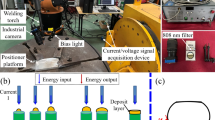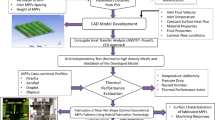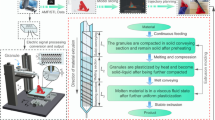Abstract
Absorber downsizing for the development of compact absorption chillers is a known challenge of this type of refrigerator. Past studies have revealed how a droplet flow regime can increase the interface area and enhance absorption rates, especially during the droplet formation. This study proposes a space-efficient design for an adiabatic absorber based on a bank of solid pins coupled with a droplet flow regime. Manufacturing through 3D printing technique is used to study the effect of different fin shapes during droplet formation. Droplet behavior is firstly studied analytically through a variational approach. Experiments on pure water are then carried out to validate the model and produce design guidelines for a H2O-LiBr absorber. Results show that the analytical model is more accurate in the regions close to the droplet bottom. The rhomboidal geometry with 120° returned the smallest droplet volume without allowing coalescence of more droplets, ensuring the maintenance of droplet flow and a high surface area for mass transfer. Disturbances in the droplet profiles were observed, caused by the pin-droplet interaction. A map has been then created to allow a quick sizing of the absorber and find its main geometrical and operational features.









Similar content being viewed by others
Abbreviations
- A:
-
Orifice cross section area (m2)
- B:
-
Curvature radius (non-dimensional)
- Bo = ρgr2/σ:
-
Bond number
- C:
-
Normalizing factor
- Cd :
-
Discharge coefficient
- d:
-
Orifice diameter (m)
- dm :
-
Droplet diameter (m)
- g:
-
Gravitational acceleration (m/s2)
- H:
-
Static head (m)
- L:
-
Pin length (m)
- Oh = μ/(ρrσ)1/2 :
-
Ohnesorge number
- P:
-
Pressure (Pa)
- Q:
-
Volume flow rate (m3/s)
- r:
-
Orifice radius (m)
- S:
-
Arc length (non-dimensional)
- u:
-
Speed (m/s)
- V:
-
Volume (non-dimensional)
- We = ρru2/σ:
-
Weber number
- X:
-
Radial coordinate (non-dimensional)
- x:
-
Radial coordinate (m)
- Z:
-
Height (non-dimensional)
- z:
-
Height (m)
- β:
-
Contact point angle
- λ:
-
Taylor wavelength
- ρ:
-
Density (kg/m3)
- σ:
-
Surface tension (N/m2)
- θ:
-
Angle (rad)
- μ:
-
Dynamic viscosity (Pa s)
- cr:
-
Critical
- d:
-
Droplet
- eq:
-
Equilibrium
- exp:
-
Experimental
- L:
-
Surrounding fluid
- o:
-
Boundary
- th:
-
Theoretical
References
Isaac M, van Vuuren DP (2009) Modeling global residential sector energy demand for heating and air conditioning in the context of climate change. Energ Policy 37:507–521. https://doi.org/10.1016/j.enpol.2008.09.051
Sivak M (2009) Potential energy demand for cooling in the 50 largest metropolitan areas of the world: implications for developing countries. Energ Policy 37:1382–1384. https://doi.org/10.1016/j.enpol.2008.11.031
Kim DS, Infante Ferreira CA (2008) Solar refrigeration options - a state-of-the-art review. Int J Refrig 31:3–15. https://doi.org/10.1016/j.ijrefrig.2007.07.011
Ammar Y, Joyce S, Norman R et al (2012) Low grade thermal energy sources and uses from the process industry in the UK. Appl Energy 89:3–20. https://doi.org/10.1016/j.apenergy.2011.06.003
Little AB, Garimella S (2011) Comparative assessment of alternative cycles for waste heat recovery and upgrade. Energy 36:4492–4504. https://doi.org/10.1016/j.energy.2011.03.069
Cola F, Romagnoli A, Hey J (2016) An evaluation of the technologies for heat recovery to meet onsite cooling demands. Energy Convers Manag 121:174–185. https://doi.org/10.1016/j.enconman.2016.05.021
Kim YJ, Joshi YK, Fedorov AG (2008) Performance analysis of air-cooled microchannel absorber in absorptionbased miniature electronics cooling system. J Mech Sci Technol 22:338–349. https://doi.org/10.1007/s12206-007-1034-5
Determan MD, Garimella S (2012) Design, fabrication, and experimental demonstration of a microscale monolithic modular absorption heat pump. Appl Therm Eng 47:119–125. https://doi.org/10.1016/j.applthermaleng.2011.10.043
Killion JD, Garimella S (2001) A critical review of models of coupled heat and mass transfer in falling film absorption. Int J Refrigeration 24(8):755–797. https://doi.org/10.1016/S0140-7007(00)00086-4
Gutiérrez-Urueta G, Huicochea A, Rodríguez-Aumente P, Rivera W (2014) Energy and exergy analysis of water-LiBr absorption systems with adiabatic absorbers for heating and cooling. Energy Procedia 57:2676–2685. https://doi.org/10.1016/j.egypro.2014.10.279
Gong S, Goni Boulama K (2014) Parametric study of an absorption refrigeration machine using advanced exergy analysis. Energy 76:453–467. https://doi.org/10.1016/j.energy.2014.08.038
Raisul Islam M, Wijeysundera N, Ho J (2003) Performance study of a falling-film absorber with a film-inverting configuration. Int J Refrig 26:909–917. https://doi.org/10.1016/S0140-7007(03)00078-1
Mortazavi M, Nasr Isfahani R, Bigham S, Moghaddam S (2015) Absorption characteristics of falling film LiBr (lithium bromide) solution over a finned structure. Energy 87:270–278. https://doi.org/10.1016/j.energy.2015.04.074
Nasr Isfahani R, Moghaddam S (2013) Absorption characteristics of lithium bromide (LiBr) solution constrained by superhydrophobic nanofibrous structures. Int J Heat Mass Transf 63:82–90. https://doi.org/10.1016/j.ijheatmasstransfer.2013.03.053
Nasr Isfahani R, Bigham S, Mortazavi M et al (2015) Impact of micromixing on performance of a membrane-based absorber. Energy 90:997–1004. https://doi.org/10.1016/j.energy.2015.08.006
Bigham S, Yu D, Chugh D, Moghaddam S (2014) Moving beyond the limits of mass transport in liquid absorbent microfilms through the implementation of surface-induced vortices. Energy 65:621–630. https://doi.org/10.1016/j.energy.2013.11.068
Hu X, Jacobi AM (1996) The intertube falling film. II. Mode effects on sensible heat transfer to a falling liquid film. J Heat Transf 118:626–633
Olbricht M, Addy J, Luke A (2016) Heat and mass transfer in a falling film evaporator with aqueous Lithium bromide solution. J Phys Conf Ser 745. https://doi.org/10.1088/1742-6596/745/3/032056
Li J, Xie X, Jiang Y (2015) Experimental study and correlation on the falling column adiabatic absorption of water vapor into LiBr–H2O solution. Int J Refrig 51:112–119. https://doi.org/10.1016/j.ijrefrig.2014.12.004
Ryan WA (1995) Adiabatic water absorption in a spray of an aqueous solution of lithium bromide. Dissertation, Illinois Institute of Technology
Palacios E, Izquierdo M, Marcos JD, Lizarte R (2009) Evaluation of mass absorption in LiBr flat-fan sheets. Appl Energy 86:2574–2582. https://doi.org/10.1016/j.apenergy.2009.04.033
Jeong S, Garimella S (2002) Falling-film and droplet mode heat and mass transfer in a horizontal tube LiBr/water absorber. Int J Heat Mass Transf 45:1445–1458. https://doi.org/10.1016/S0017-9310(01)00262-9
Ben Hafsia N, Chaouachi B, Gabsi S (2015) A study of the coupled heat and mass transfer during absorption process in a spiral tubular absorber. Appl Therm Eng 76:37–46. https://doi.org/10.1016/j.applthermaleng.2014.10.079
Tomforde C, Luke A (2012) Experimental investigations on falling-film absorbers with horizontal tubes – a review. Int Refrig Air Cond Conf Purdue Paper 1193. http://docs.lib.purdue.edu/iracc/1193. Accessed 13 Jul 2017
Teng H, Kinoshita CM, Masutani SM (1995) Prediction of droplet size from the breakup of cylindrical liquid jets. Int J Multiphase Flow 21:129–136. https://doi.org/10.1016/0301-9322(94)00053-M
Grant RP, Middleman S (1966) Newtonian jet stability. AIChE J 12:669–678. https://doi.org/10.1002/aic.690120411
Ambravaneswaran B, Subramani HJ, Phillips SD, Basaran OA (2004) Dripping-jetting transitions in a dripping faucet. Phys Rev Lett 93:34501–34501. https://doi.org/10.1103/PhysRevLett.93.034501
Clanet C, Lasheras JC (2017) Transition from dripping to jetting. J Fluid Mech 383:307–326. https://doi.org/10.1017/S0022112098004066
Eggers J, Villermaux E (2008) Physics of liquid jets. Rep Prog Phys 71:1–79. https://doi.org/10.1088/0034-4885/71/3/036601
Hollingshead CL, Johnson MC, Barfuss SL, Spall RE (2011) Discharge coefficient performance of Venturi, standard concentric orifice plate, V-cone and wedge flow meters at low Reynolds numbers. J Pet Sci Eng 78:559–566. https://doi.org/10.1016/j.petrol.2011.08.008
Wang X, Jacobi AM (2014) A thermodynamic basis for predicting falling-film mode transitions. Int J Refrig 43:123–132. https://doi.org/10.1016/j.ijrefrig.2014.04.002
Pitts E (1974) The stability of pendent liquid drops. Part 2. Axial symmetry. J Fluid Mech 63:487. https://doi.org/10.1017/S0022112074001741
Ramesh Babu S (1987) Analysis of drop formation at conical tips. 1. Theory. J Colloid Interface Sci 116:350–358. https://doi.org/10.1016/0021-9797(87)90131-7
Yuan Z, Herold K (2005) Thermodynamic properties of aqueous Lithium bromide using a multiproperty free energy correlation. HVAC&R Res 11:377–393. https://doi.org/10.1080/10789669.2005.10391144
Yuan Z, Herold K (2001) Surface tension of pure water and aqueous lithium bromide with 2-ethyl-hexanol. Appl Therm Eng 21:881–897. https://doi.org/10.1016/S1359-4311(00)00088-0
Author information
Authors and Affiliations
Corresponding author
Ethics declarations
Conflict of interest
On behalf of all authors, the corresponding author states that there is no conflict of interest.
Additional information
Publisher’s Note
Springer Nature remains neutral with regard to jurisdictional claims in published maps and institutional affiliations.
Appendix – Validation of droplet formation model for different pin shapes
Appendix – Validation of droplet formation model for different pin shapes








Rights and permissions
About this article
Cite this article
Cola, F., Romagnoli, A. & Hey, J. Experimental study on the droplet formation around pins of different geometry for the design of a compact falling-droplet absorber. Heat Mass Transfer 54, 3599–3616 (2018). https://doi.org/10.1007/s00231-018-2381-8
Received:
Accepted:
Published:
Issue Date:
DOI: https://doi.org/10.1007/s00231-018-2381-8




